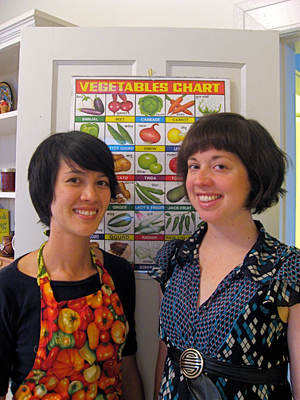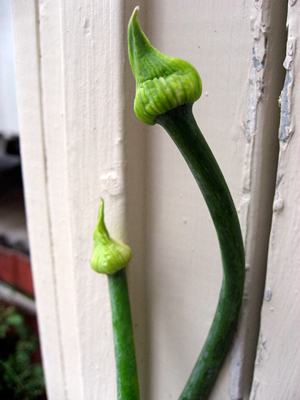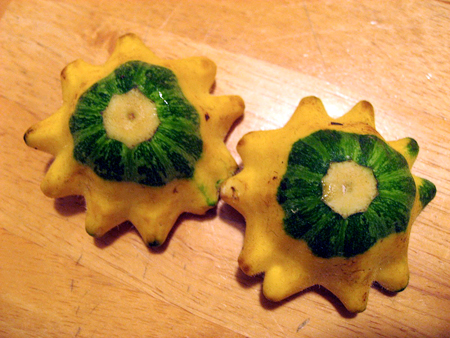 The joint endeavor of Mission District housemates Kale Daikon and Eggplant Kohlrabi (a.k.a. Katrina Dodson and Erin Klenow), Weird Vegetables sprouts a cut above most local food blogs. Do not, for starters, confuse it with a younger, much less weird San Francisco-based rival going by the same name, a site dedicated, seemingly quite seriously, to "celebrating diversity throughout the plant kingdom." In contrast, the one of which I write inhabits a special dimension of biological whimsy, where the crisper spills forth a menagerie of anthropomorphic leaves, roots, and legumes, and a trip to the farmer's market feels like a twisted safari through unfamiliar lands. Stuffed into the blog's strange sieve of language and thought, vegetables are not merely waxed, sticker-tagged produce; they are characters. Identities, needs, wants, and feelings squirm within their husks and peels as well as flavors and nutrients. For Dodson and Klenow, they are ripe springboards for gleeful leaps into philosophy, linguistics, and general poetic absurdity as well as cookery.
The joint endeavor of Mission District housemates Kale Daikon and Eggplant Kohlrabi (a.k.a. Katrina Dodson and Erin Klenow), Weird Vegetables sprouts a cut above most local food blogs. Do not, for starters, confuse it with a younger, much less weird San Francisco-based rival going by the same name, a site dedicated, seemingly quite seriously, to "celebrating diversity throughout the plant kingdom." In contrast, the one of which I write inhabits a special dimension of biological whimsy, where the crisper spills forth a menagerie of anthropomorphic leaves, roots, and legumes, and a trip to the farmer's market feels like a twisted safari through unfamiliar lands. Stuffed into the blog's strange sieve of language and thought, vegetables are not merely waxed, sticker-tagged produce; they are characters. Identities, needs, wants, and feelings squirm within their husks and peels as well as flavors and nutrients. For Dodson and Klenow, they are ripe springboards for gleeful leaps into philosophy, linguistics, and general poetic absurdity as well as cookery.
 Each entry often starts with a vegetable one of them has picked up at the store or market. From there, the specimen is assessed, first as object, then as food, an introduction irrigated with historical context and preparation suggestions, and subsequently sacrificed at the altar of their imagination. Take, for example, the August 2008 post on the lemon cucumber, in which Dodson sums up the chosen veggie as "a piece of produce that boasts the vaguely exotic yet familiar allure of the hybrid, the indeterminate, the mestizo...this fruit masquerading as a vegetable disguised as a fruit (a kind of double drag, F to V to F)." In the April 2009 treatise on farro ("Long Ago, a Farro Way"), a lisp-kissed summary of The Princess Bride acts as preamble to a discussion of the ancient grain's venerability and value, "farro" being, after all, a word perhaps best spoken with "a faraway look" in one's eyes. Clearly, vegetables are weird, often much weirder than we think, and the ways in which people treat these things they plant and eat says something about people too: namely, that they are weird as well. In early June, I visited the bloggers at their house. We skipped through the magic mustard greens garden, scouted scapes, and talked turnips.
Each entry often starts with a vegetable one of them has picked up at the store or market. From there, the specimen is assessed, first as object, then as food, an introduction irrigated with historical context and preparation suggestions, and subsequently sacrificed at the altar of their imagination. Take, for example, the August 2008 post on the lemon cucumber, in which Dodson sums up the chosen veggie as "a piece of produce that boasts the vaguely exotic yet familiar allure of the hybrid, the indeterminate, the mestizo...this fruit masquerading as a vegetable disguised as a fruit (a kind of double drag, F to V to F)." In the April 2009 treatise on farro ("Long Ago, a Farro Way"), a lisp-kissed summary of The Princess Bride acts as preamble to a discussion of the ancient grain's venerability and value, "farro" being, after all, a word perhaps best spoken with "a faraway look" in one's eyes. Clearly, vegetables are weird, often much weirder than we think, and the ways in which people treat these things they plant and eat says something about people too: namely, that they are weird as well. In early June, I visited the bloggers at their house. We skipped through the magic mustard greens garden, scouted scapes, and talked turnips.
Andrew Simmons: I like how your blog shares practical advice about actually cooking vegetables but also presents them as vibrant players in a somewhat goofy bio-cultural drama. What got you into vegetables? Did the blog evolve organically?
Katrina Dodson: I go to farmers' markets all the time and I spend a lot of time around food people, so I've learned something about vegetables from them as well.
AS: Why are vegetables weird?
KD: Certain types of vegetables can be weird because people don't normally eat them or aren't used to them, or they can be more common individual vegetables, like carrots and potatoes, that just look weird. I'm also really interested in the weirdness of language and how strange the naming of vegetables can be. I'm working on a Ph.D. in comparative literature right now so I think about metaphors all the time. That's the latest level of weirdness on the blog, the newest terrain.
Erin Klenow: I like how the name of a vegetable can freak someone out. The fact that something is called a blood orange is enough to get people to avoid eating it. And nipple fruit? It's pretty funny.
